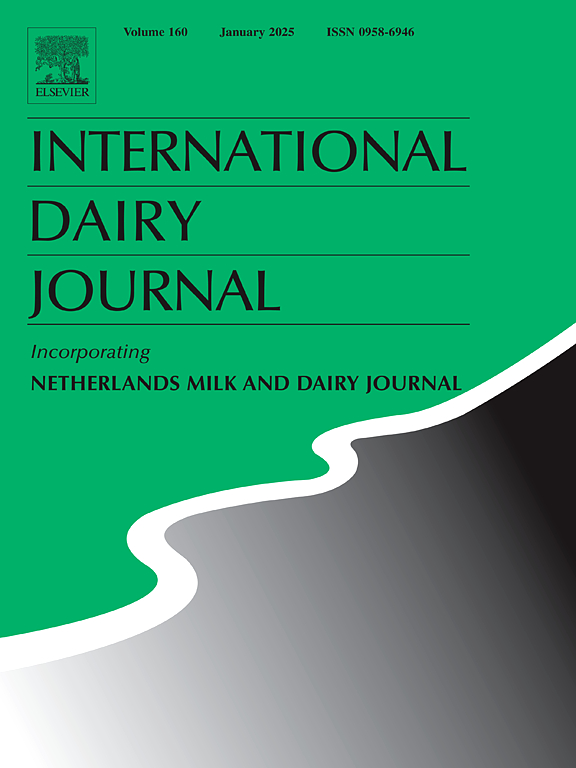蛋清蛋白介导的酸奶凝胶性质的调节:理化性质、结构演变和网络形成机制
IF 3.4
3区 农林科学
Q2 FOOD SCIENCE & TECHNOLOGY
引用次数: 0
摘要
为了响应对清洁标签食品日益增长的需求,本研究探索了蛋清蛋白(EWP)作为酸诱导凝固酸奶中合成增稠剂的天然替代品的凝胶功能。通过理化表征、微观结构评价和凝胶网络形成分析EWP对酸奶品质的调控机制。对蛋清(EW)添加量(0 - 50%)的系统评估表明,添加10%的EW可显著提高凝胶性能,同时维持符合国家标准的活乳酸菌数量。与对照组相比,10% EW配方的保水能力提高了12.8%,硬度提高了24.3%,储存模量(G′)提高了34.18%。微观结构分析(SEM)、红外光谱(FTIR)和分子间力定量分析表明,复合凝胶形成了一个紧凑的三维网络,由ewp -酪蛋白相互作用机制控制:β-片构象形成、疏水相互作用和二硫键稳定。疏水力和二硫键之间的协同交联被认为是结构完整性的关键。风味分析证实,10% EW酸奶中保留了特有的乳制品相关化合物(壬醛,2-十一烷酮)。本研究阐明了酸诱导凝胶体系中EW与酪蛋白之间的剂量依赖关系,为开发标签干净、减少后酸化的酸奶提供了科学依据。本文章由计算机程序翻译,如有差异,请以英文原文为准。

Egg white protein-mediated modulation of yogurt gel properties: Physicochemical attributes, structural evolution, and network formation mechanisms
In response to the growing demand for clean-label food products, this study explored the gelling functionality of egg white protein (EWP) as a natural alternative to synthetic thickeners in acid-induced coagulated yogurt. The regulatory mechanism of EWP on yogurt quality was analyzed through physicochemical characterization, microstructural evaluation, and gel network formation. Systematic assessment of egg white (EW) addition (0–50 %) demonstrated that incorporation of 10 % EW significantly enhanced gel properties while maintaining viable lactic acid bacteria counts compliant with national standards. Compared to the control, the 10 % EW formulation exhibited a 12.8 % increase in water-holding capacity, 24.3 % higher hardness, and 34.18 % elevation in storage modulus (G’). Microstructural analysis (SEM), FTIR spectroscopy, and intermolecular force quantification revealed that the composite gel developed a compact three-dimensional network governed by the EWP-casein interaction mechanism: β-sheet conformation formation, hydrophobic interactions, and disulfide bond stabilization. Synergistic cross-linking between hydrophobic forces and disulfide bonds was identified as critical for structural integrity. Flavor analysis confirmed the retention of characteristic dairy-associated compounds (nonanal, 2-undecanone) in the 10 % EW yogurt. This work elucidated the dose-dependent relationship between EW and casein in acid-induced gel systems, providing a scientific foundation for developing yogurts with clean labels and reduced post-acidification.
求助全文
通过发布文献求助,成功后即可免费获取论文全文。
去求助
来源期刊

International Dairy Journal
工程技术-食品科技
CiteScore
6.50
自引率
9.70%
发文量
200
审稿时长
49 days
期刊介绍:
The International Dairy Journal publishes significant advancements in dairy science and technology in the form of research articles and critical reviews that are of relevance to the broader international dairy community. Within this scope, research on the science and technology of milk and dairy products and the nutritional and health aspects of dairy foods are included; the journal pays particular attention to applied research and its interface with the dairy industry.
The journal''s coverage includes the following, where directly applicable to dairy science and technology:
• Chemistry and physico-chemical properties of milk constituents
• Microbiology, food safety, enzymology, biotechnology
• Processing and engineering
• Emulsion science, food structure, and texture
• Raw material quality and effect on relevant products
• Flavour and off-flavour development
• Technological functionality and applications of dairy ingredients
• Sensory and consumer sciences
• Nutrition and substantiation of human health implications of milk components or dairy products
International Dairy Journal does not publish papers related to milk production, animal health and other aspects of on-farm milk production unless there is a clear relationship to dairy technology, human health or final product quality.
 求助内容:
求助内容: 应助结果提醒方式:
应助结果提醒方式:


